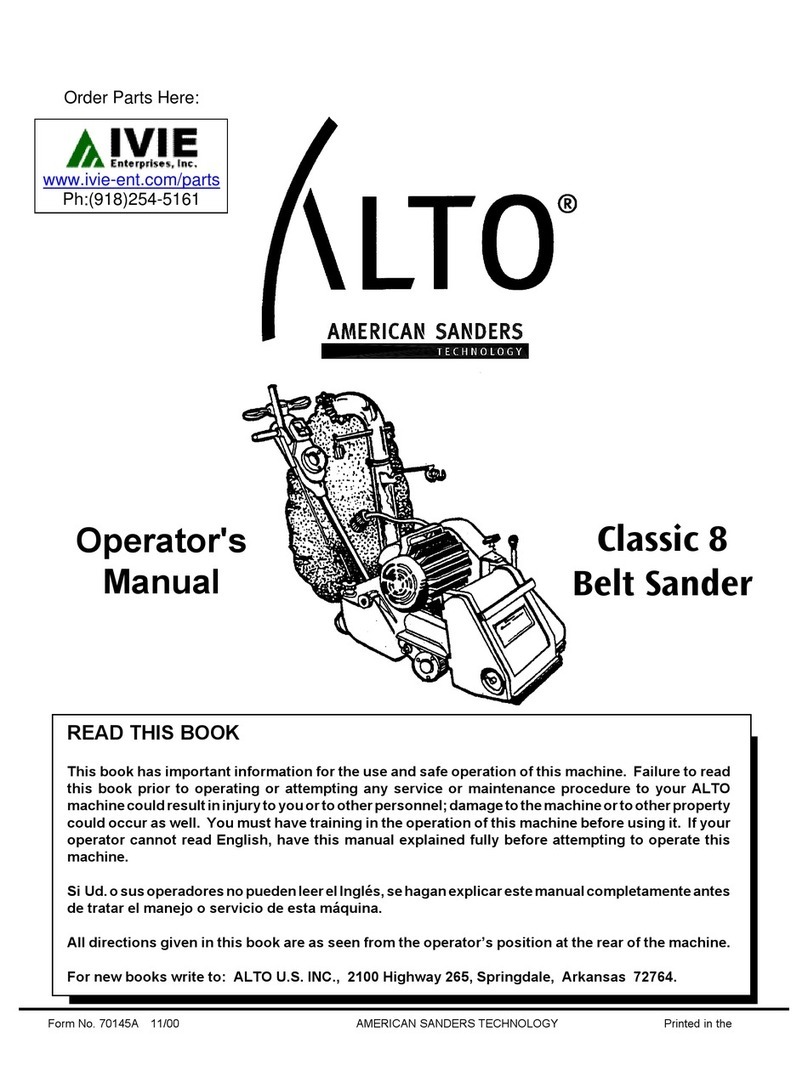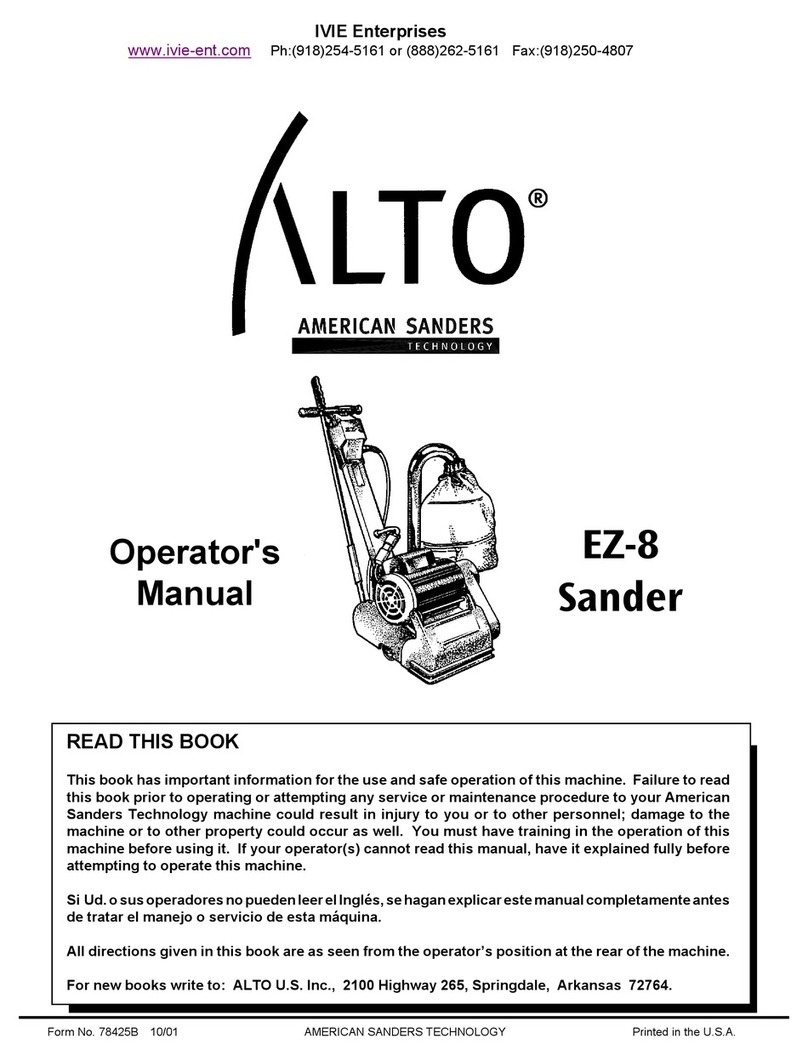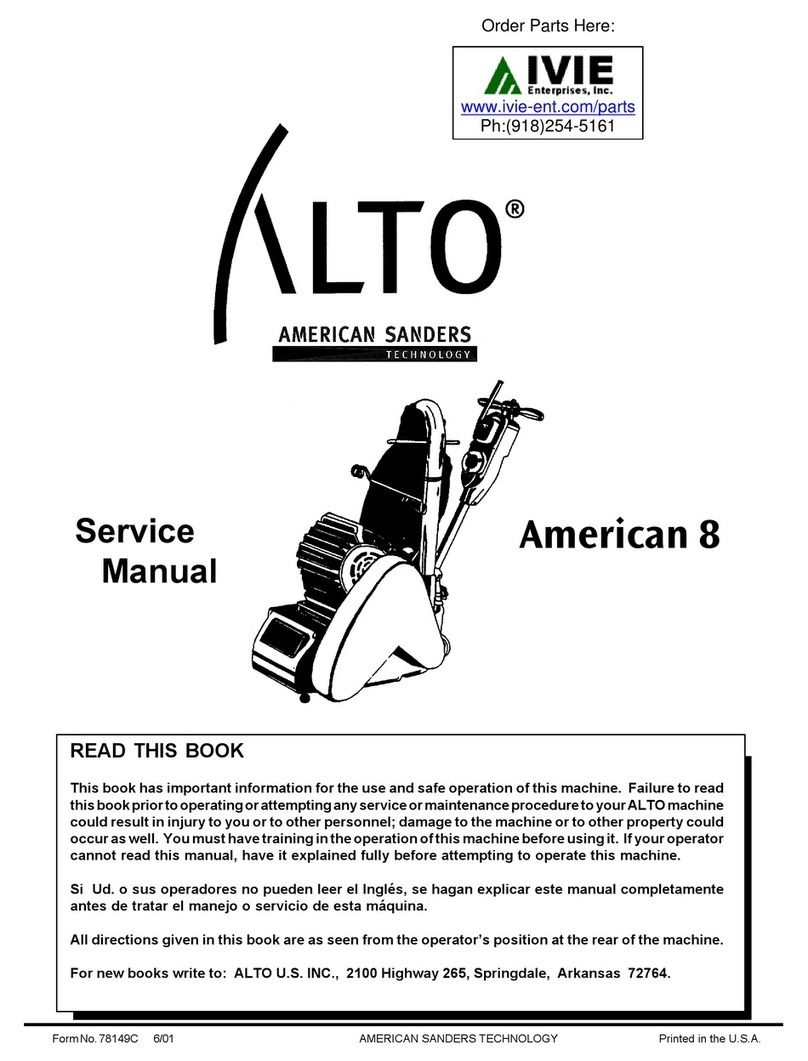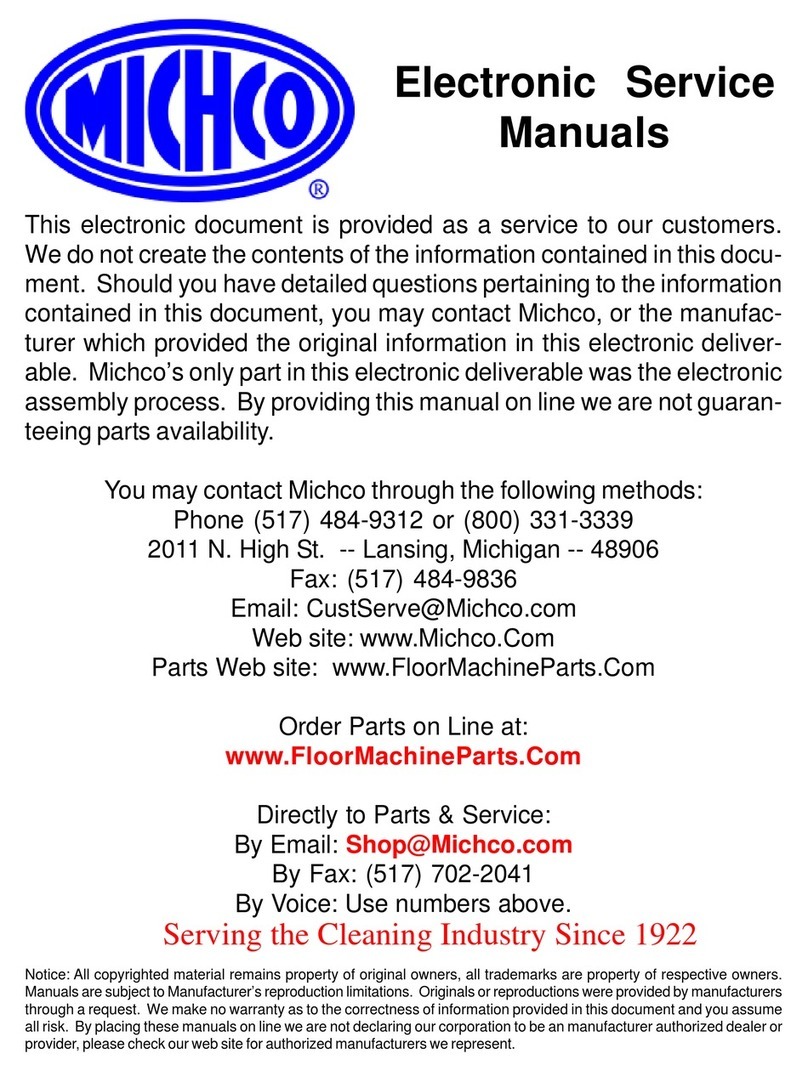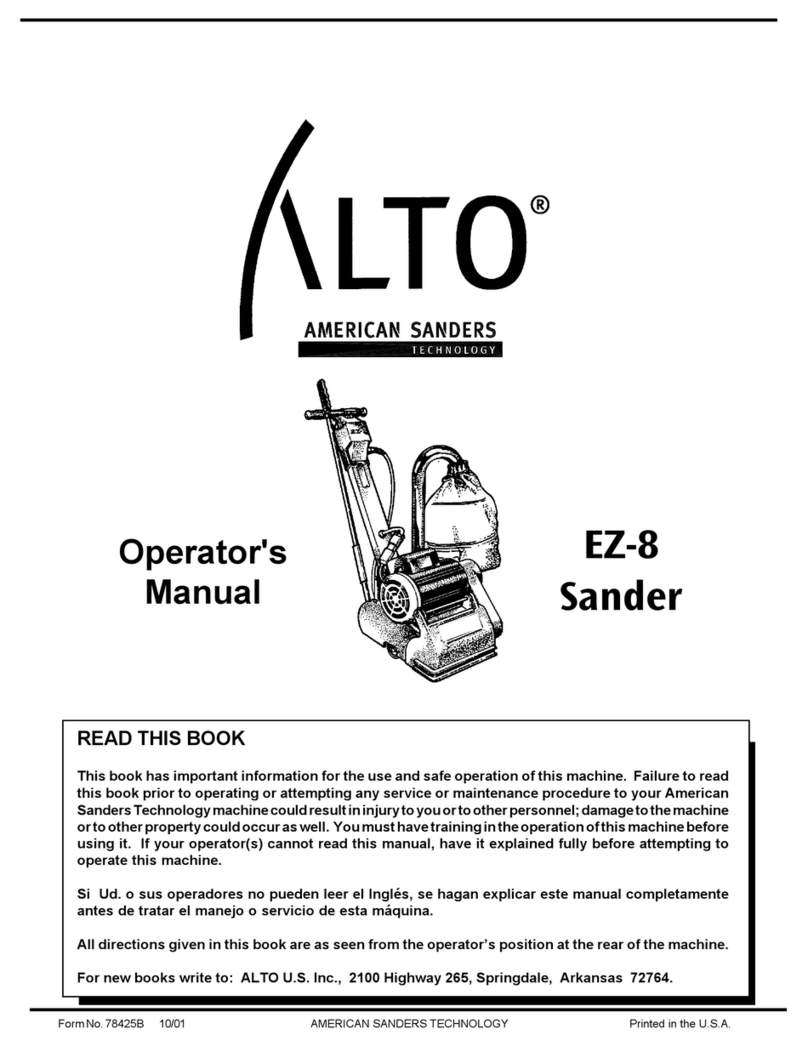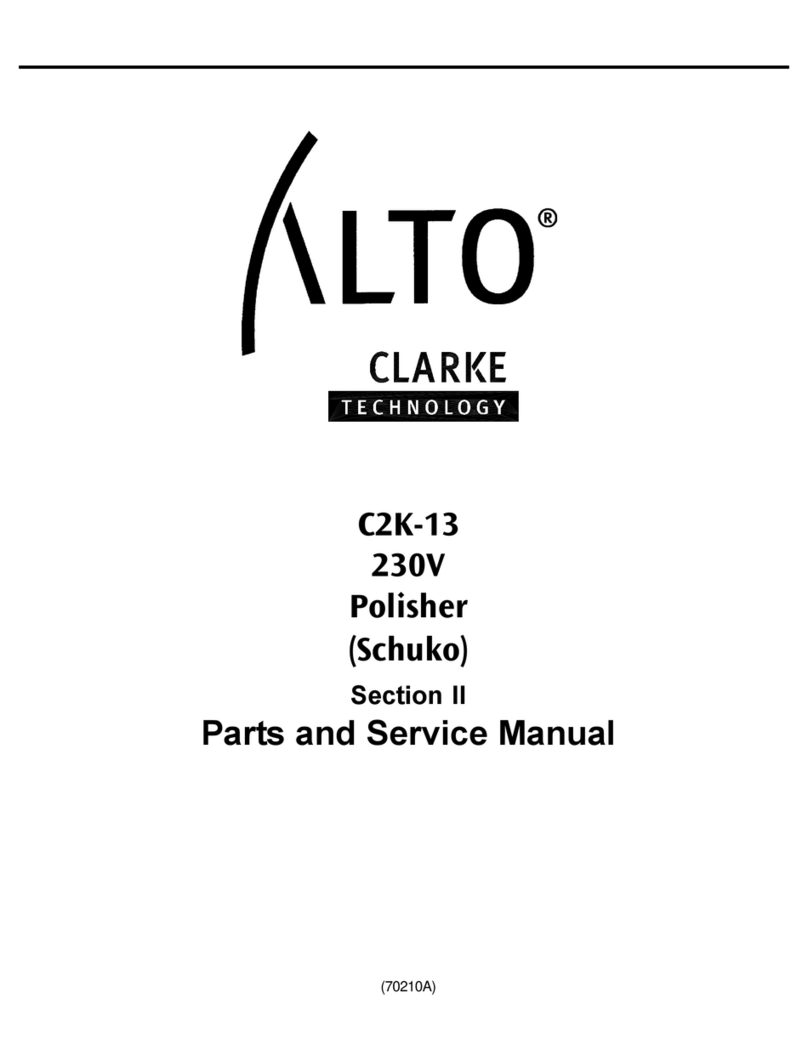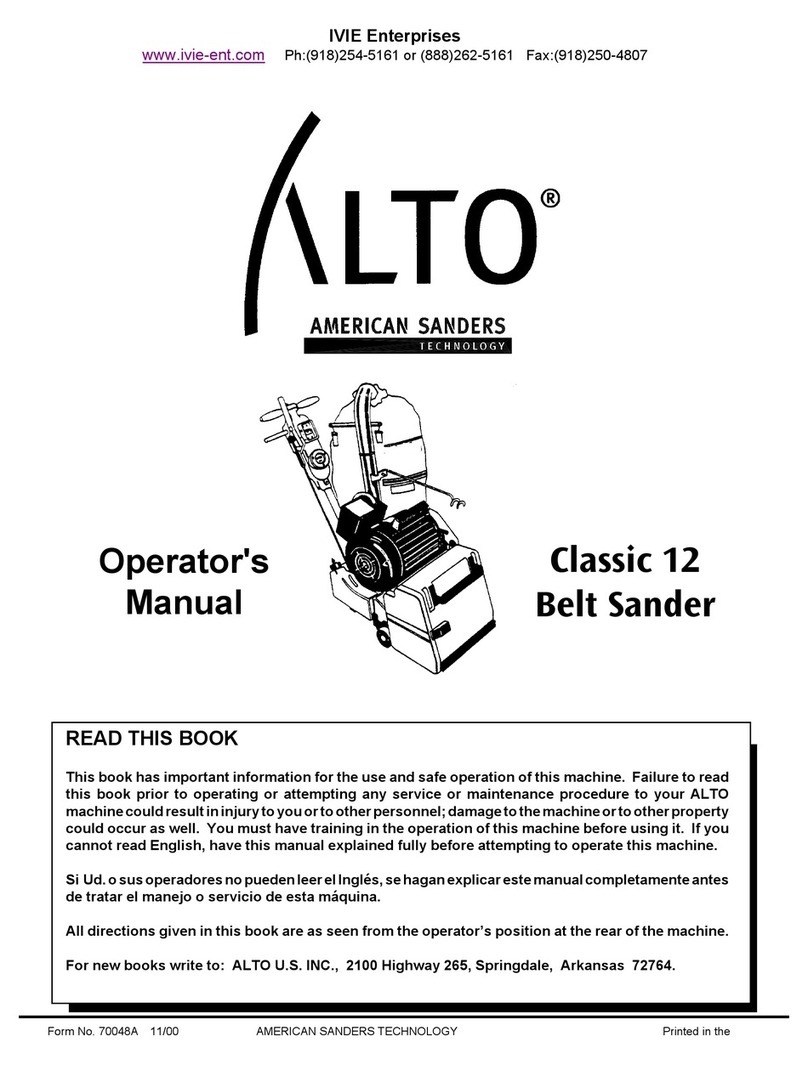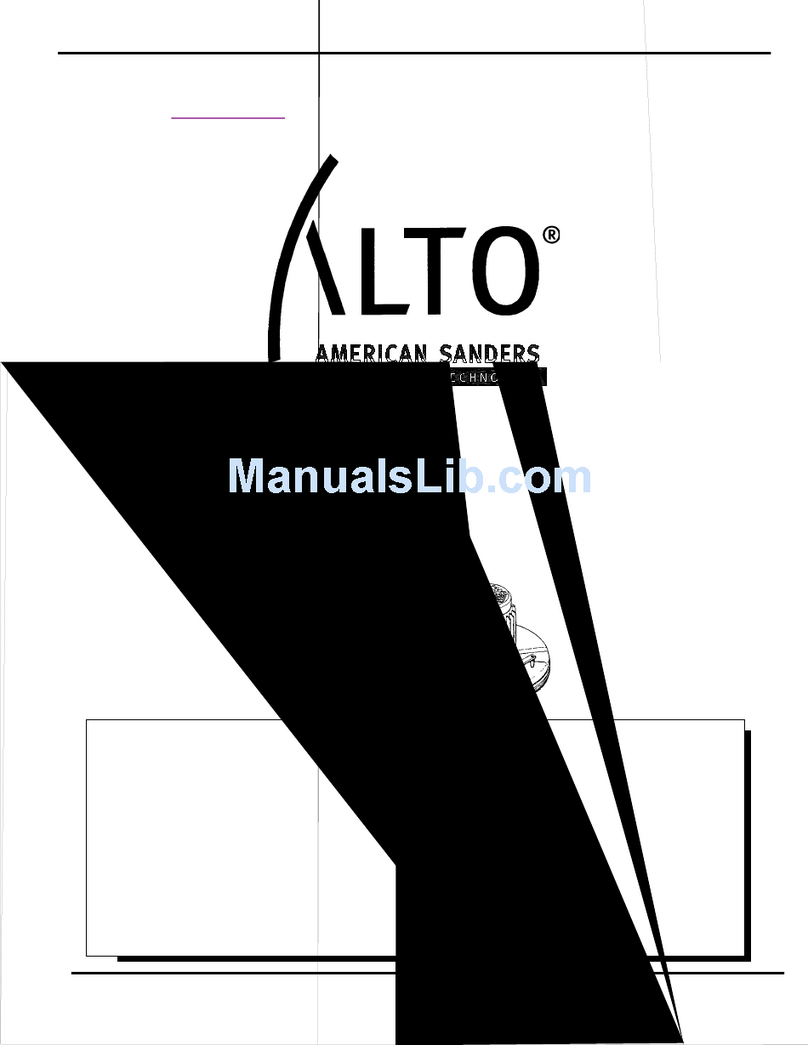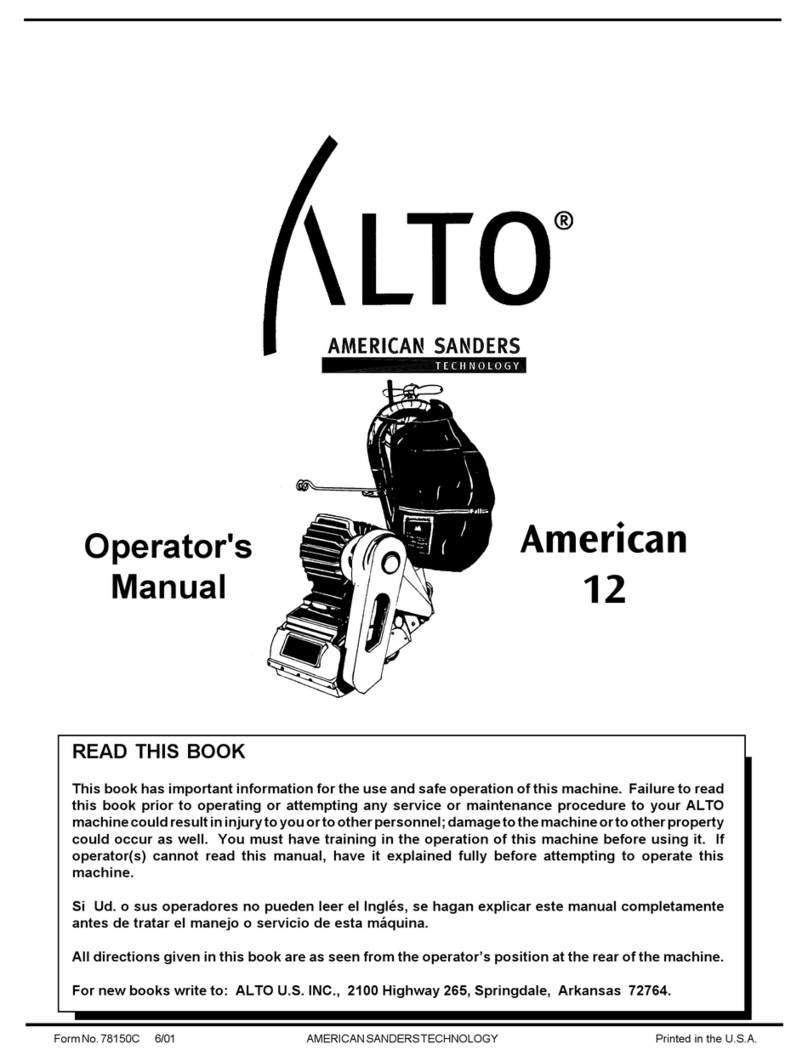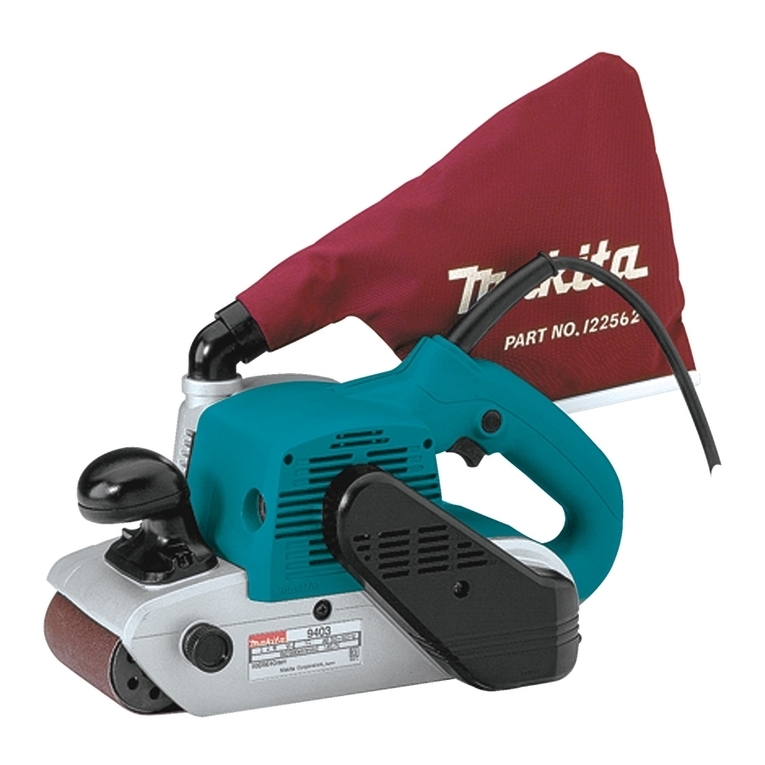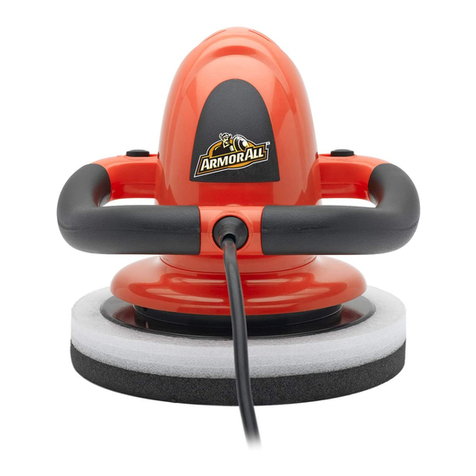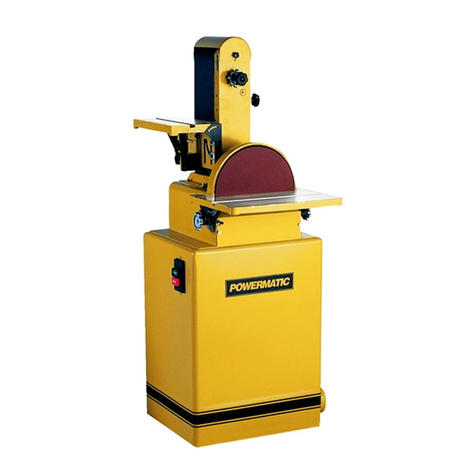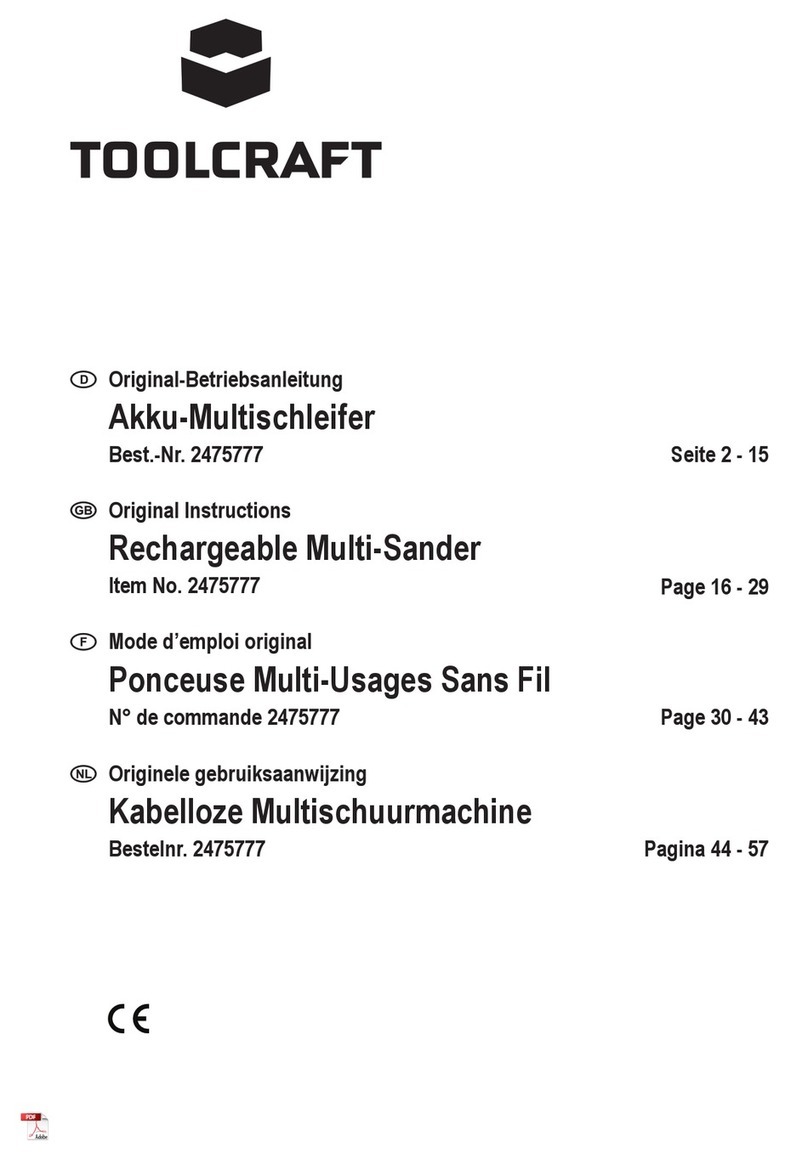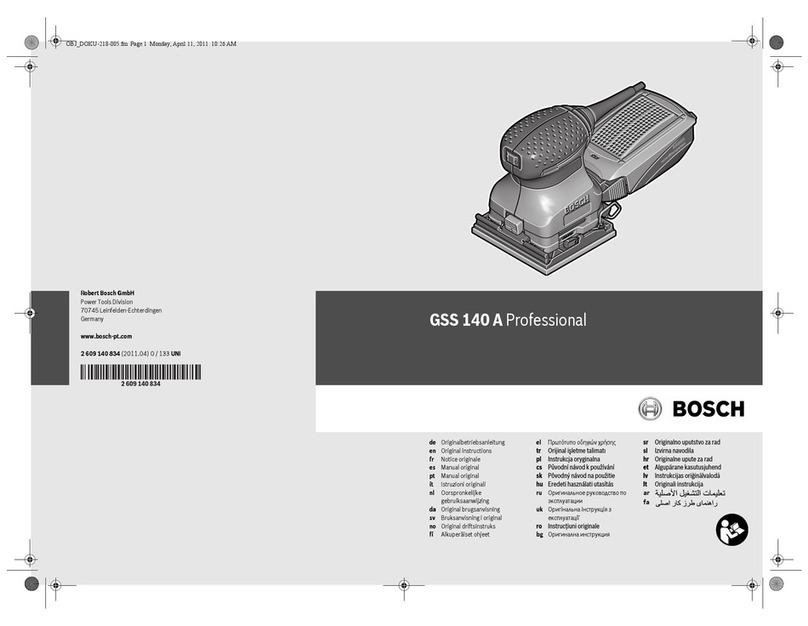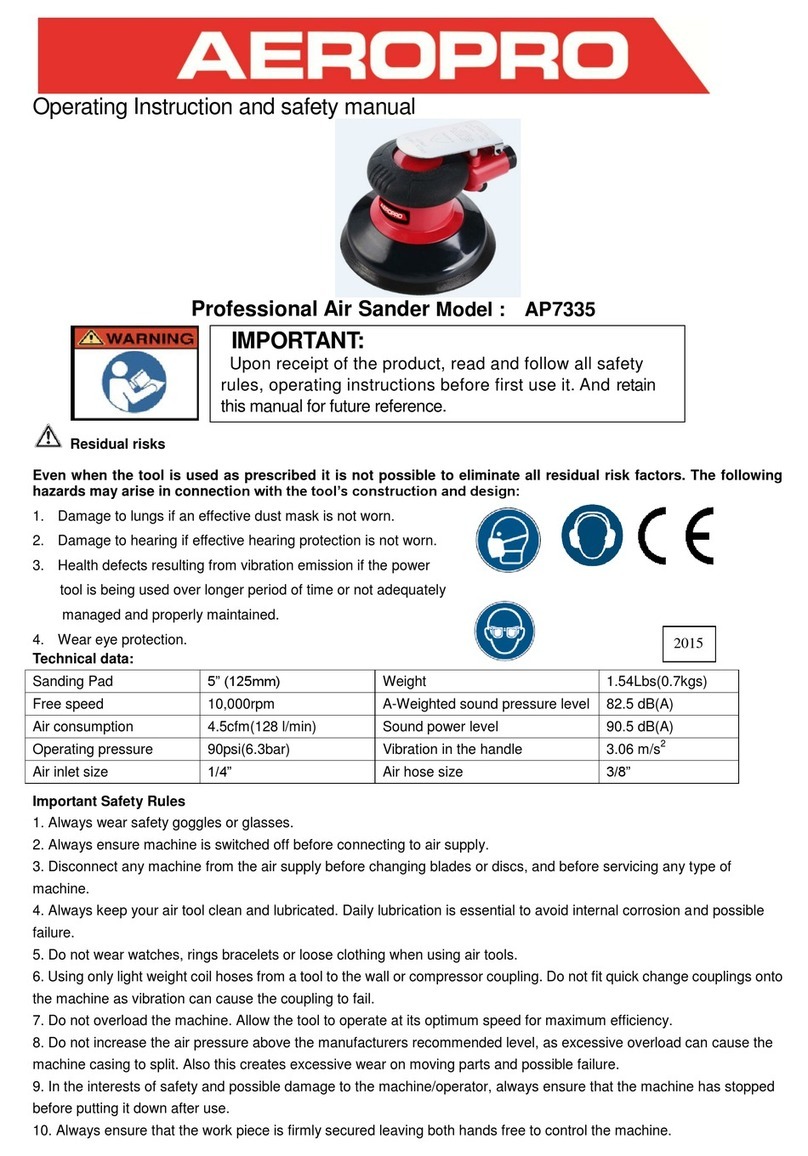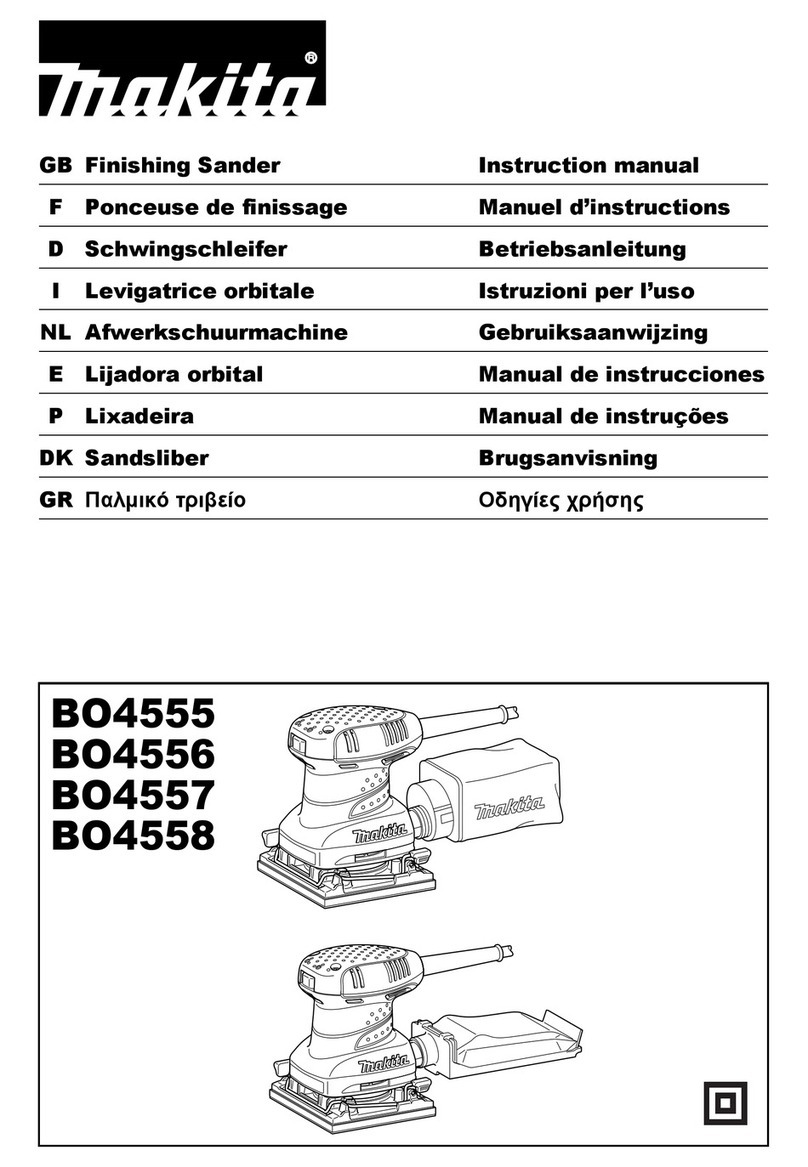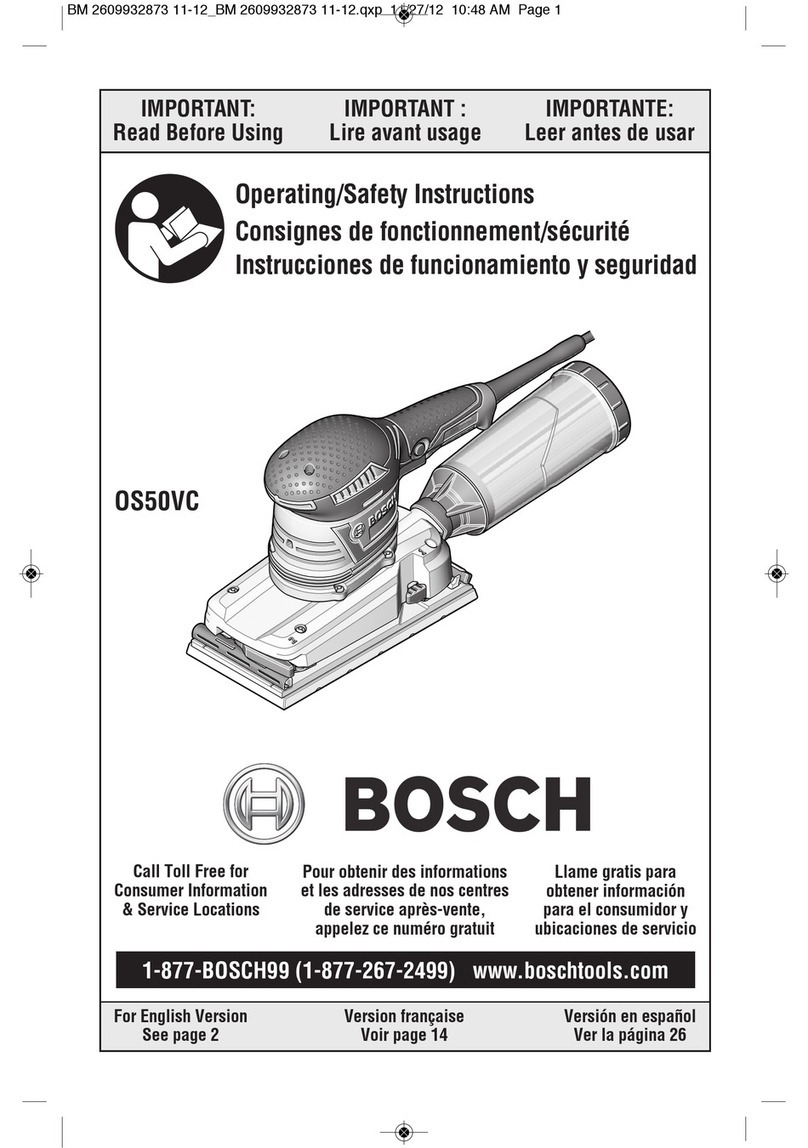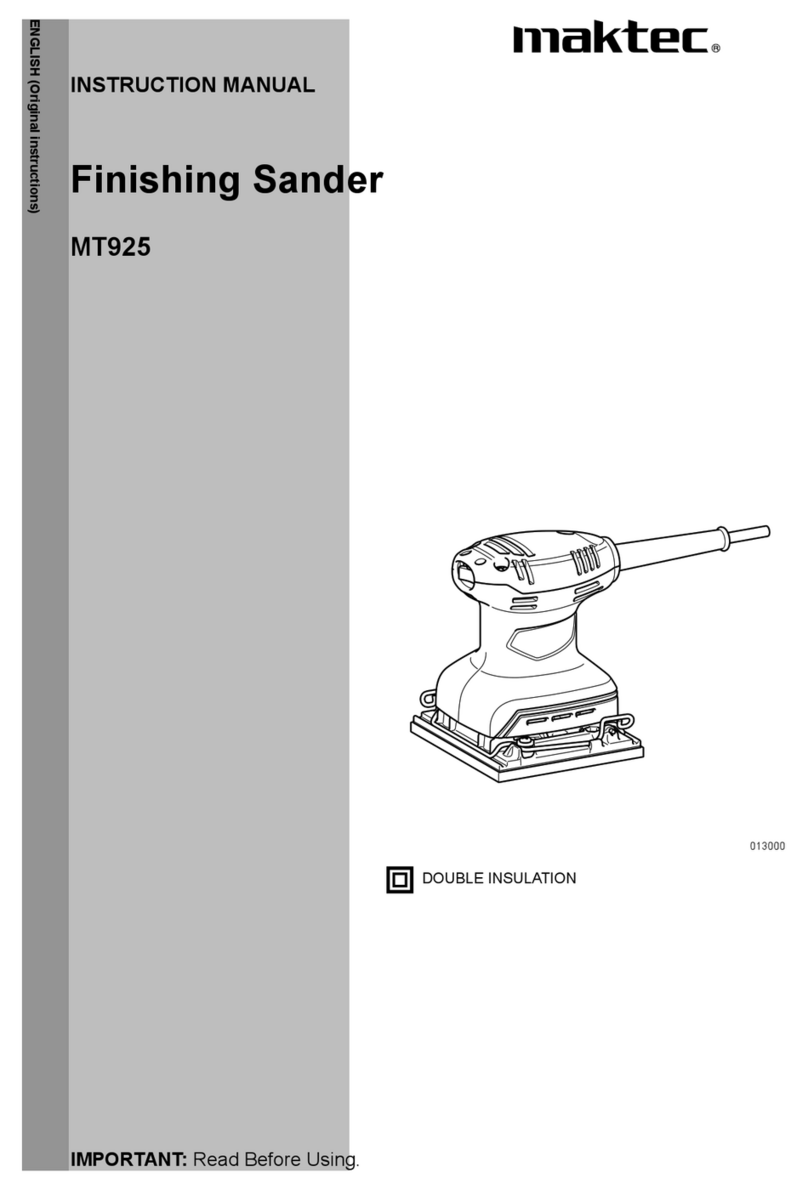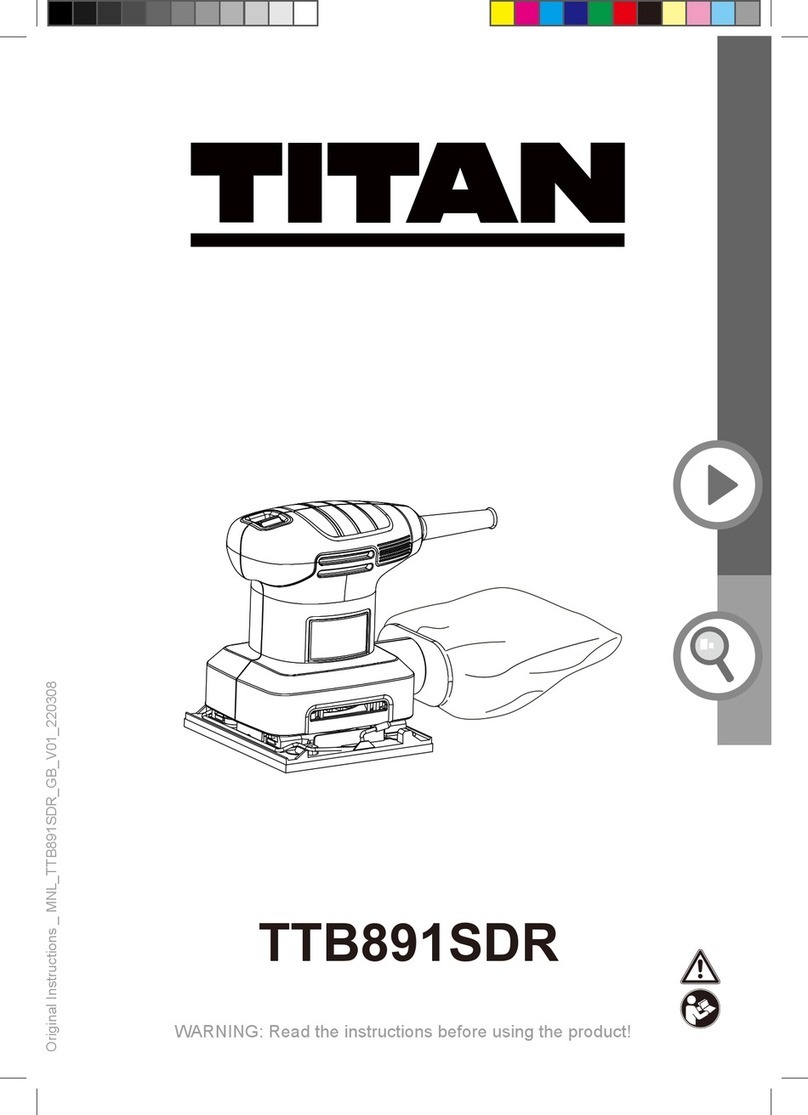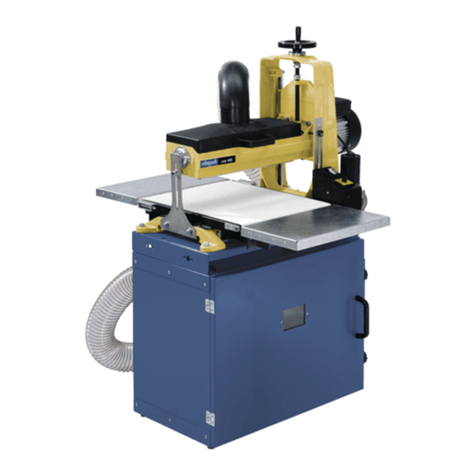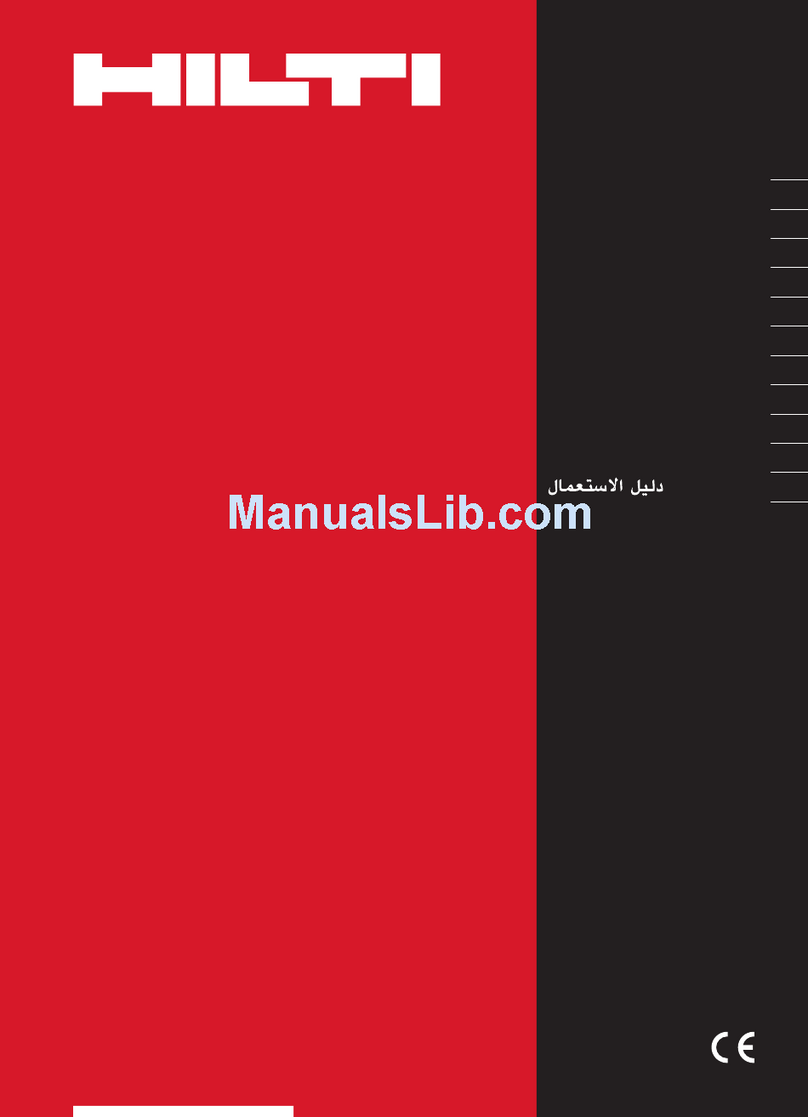Alto Apollo 8 User manual

Form No. 70141A 12/00 AMERICAN SANDERS TECHNOLOGY Printed in the U.S.A.
READ THIS BOOK
This book has important information for the use and safe operation of this machine. Failure to read
this book prior to operating or attempting any service or maintenance procedure to your ALTO
machine could result in injury to you or to other personnel; damage to the machine or to other property
could occur as well. You must have training in the operation of this machine before using it. If you
cannot read English, have this manual explained fully before attempting to operate this machine.
Si Ud. o sus operadores no pueden leer el Inglés, se hagan explicar este manual completamente antes
de tratar el manejo o servicio de esta máquina.
All directions given in this book are as seen from the operator’s position at the rear of the machine.
For new books write to: ALTO U.S. INC., 2100 Highway 265, Springdale, Arkansas 72764.
Operator's
Manual
Apollo 8
Belt Sander
Order Parts Here:
www.ivie-ent.com/parts
Ph:(918)254-5161

Page 2 AMERICAN SANDERS TECHNOLOGY Apollo 8 Operator's Manual
OperatorSafetyInstructions .........................................................3
IntroductionandMachineSpecifications.......................................5
230VElectricalConnectionInstructions........................................6
HowtoTransporttheMachine ......................................................7
OnePerson ..............................................................................7
TwoPeople ..............................................................................8
MachineSet-Up ...........................................................................8
HowtoOperatetheMachine ......................................................10
SandingCutsand Sandpaper .................................................. 12
ChatterWavePrevention ...........................................................13
SanderAdjustmentProcedures..................................................14
Dust Shoe ..............................................................................14
Sanding Pressure...................................................................14
Belt Tracking ..........................................................................15
Operating Control ...................................................................15
RoutineMaintenance..................................................................16
Sanding Chamber ..................................................................16
Wheels ...................................................................................16
Dust Bag ................................................................................16
Drive Belt ...............................................................................16
Bearings.................................................................................17
Rollers....................................................................................17
Troubleshooting .........................................................................18
AssemblyDrawing #1 ................................................................20
Assembly Parts List #1...........................................................21
TensionAssemblyDrawing ........................................................22
TensionAssemblyParts .........................................................23
AssemblyDrawing #2 ................................................................24
Assembly Parts List #2...........................................................25
AssemblyDrawing #3 ................................................................26
Assembly Parts List #3...........................................................27
Wiring Diagram..........................................................................28
Table of Contents

AMERICAN SANDERS TECHNOLOGY Apollo 8 Operator's Manual Page 3
DANGERmeans: Severe bodily injuryor death can occur to youor other personnel if the DAN-
GER statementsfound on thismachine orinthis Owner'sManual are ignored
or arenot adhered to. Read and observeall DANGER statements foundin this
Owner'sManualandonyourmachine.
WARNINGmeans: Injury can occur to you or to other personnel if the WARNING statements
foundon yourmachine orinthis Owner'sManual areignored orare not
adheredto. Readand observeall WARNINGstatementsfoundinthisOwner's
Manualandonyourmachine.
CAUTIONmeans: Damage can occur to the machine or to other property if the CAUTION state-
mentsfound on yourmachineor in thisOwner'sManual are ignoredor are not
adheredto. Readandobserve allCAUTION statementsfoundinthisOwner's
Manualandonyourmachine.
DANGER: Failuretoread theOwner'sManual priortooperatingorattemptinganyserviceormainte-
nanceprocedure to yourAmerican SandersTechnologymachine couldresultin injuryto
you or to other personnel; damage to the machine or to other property could occur as well.
You must have training in the operation of this machine before using it. If you cannot
read English, have this manual explained fully before attempting to operate this
machine.
DANGER: Sanding/finishingwoodfloorscancreateanenvironmentthatcanbeexplosive. The
followingsafetyproceduresmustbeadheredto:
• Cigarette lighters, pilot lights and any other source of ignition can create an explosion
when active during a sanding session. All sources of ignition should be extinguished or
removedentirelyifpossiblefromtheworkarea.
• Workareasthatarepoorlyventilatedcancreateanexplosiveenvironmentwhencertain
combustible materials are in the atmosphere, i.e., solvents, thinners, alcohol, fuels,
certain finishes, wood dust and other combustible materials. Floor sanding machines
cancauseflammablematerialand vaporsto burn. Readthe manufacturer'slabelonall
chemicals used to determine combustibility. Keep the work area well ventilated.
• Spontaneouscombustion or an explosioncan occur whenworkingwith sanding dust.
The sanding dust can ignite and cause injury or damage. Sanding dust should be
disposed of properly. Always empty the sanding dust into a metal container that is
locatedoutsideof anybuilding(s).
• Remove the contents of the dust bag when the bag is 1/3 full. Remove the contents of
the dust bag each time you finish using the machine. Never leave a dust bag unattended
with sanding dust in it.
• Do not empty the contents of the dust bag into a fire.
• Hitting a nail while sanding can cause sparks and create an explosion or fire. Always
useahammer and punch to countersinkallnails before sanding floors.
DANGER: Operating a machine that is not completely or fully assembled could result in injury or
property damage. Do not operate this machine until it is completely assembled. Keep
all fasteners tight. Keep adjustments according to machine specifications.
WARNING AVERTISSEMENT ADVERTENCIA
OPERATOR SAFETY INSTRUCTIONS

Page 4 AMERICAN SANDERS TECHNOLOGY Apollo 8 Operator's Manual
DANGER: Electrocution could occur if maintenance and repairs are performed on a unit that is not
disconnected from the power supply. Disconnect the power supply before attempting any
maintenance or service.
DANGER: Electrocution could occur if machine is used on ungrounded electrical circuit. Never remove
or disable the grounding supply conductor on the electrical cord. Consult an electrician if the
grounding conductor is missing or if you suspect your circuit is not grounded properly.
DANGER: Use of this machine with a damaged power cord could result in an electrical shock. Do not
use the machine if the power cord is damaged. Do not use the electrical cord to move the
machine.
DANGER: Electrocution or injury could occur if the power cord is run over or damaged by the sander.
Keep the cord free from under the machine to avoid contact with the sandpaper. Always lift
the power cord over the machine.
DANGER: Moving parts of this machine can cause serious injury and/or damage. Keep hands, feet and
loose clothing away from all moving parts of the sander.
DANGER: Operating a sander without all guards, doors or covers in place can cause an injury or damage.
Always check to make sure that all of the guards, doors and covers are secure and in place.
DANGER: Injury to the operator or bystanders could occur if the machine's power is on while performing
maintenance, changing or adjusting the belt, or changing the dust bag.
DANGER: Attempting to adjust the belt tracking while the machine is on can cause injury and/or damage.
Do not perform belt tracking adjustments while sanding equipment is running.
WARNING: Fire could occur if the machine is used on a power circuit that repeatedly trips or is undersized.
Have a licensed electrician check the fuse, circuit breaker or power supply.
WARNING: Failure to read and observe all safety statements found on your machine or in this Owner's
Manual can result in serious injury or damage. Read and observe all safety statements. Make
sure that all labels, decals, warnings, cautions, and instructions are fastened to the machine.
Get new labels from your authorized American Sanders Technology distributor.
WARNING: In the event of a bag fire, injury can occur to the operator if the operator is tied or strapped to
equipment. Use operating belt properly ( follow procedure on page 8).
WARNING: Injury to the operator or bystander can occur if protective gear is not worn while sanding.
Always use eye, ear, and respiratory protection while performing any sanding operation.
WARNING: Bodily injury could occur if power is applied to the machine with the power switch already in
the "ON" position. Always check to assure that the power switch is in the "OFF" position
before connecting power supply.
CAUTION: Maintenance and repairs performed by unauthorized personnel could result in damage or
injury. Maintenance and repairs performed by unauthorized personnel will void your warranty.
Servicing of this unit must always be referred to an authorized American Sanders Technology
distributor.
CAUTION: Use of this machine to move other objects or to climb on could result in injury or damage. Do
not use this machine as a step or furniture. Do not ride on this machine.
CAUTION: Damage could occur to the machine if not properly kept in a dry building for storage. Store
the machine in a dry building.
CAUTION: The machine is heavy. When transporting the machine, remove the motor. Get help to lift
the machine and motor.
CAUTION: Serious damage to the floor can occur if the machine is left running in one spot while the
sandingdrumisin contact withthefloor. Toavoiddamage to thefloor, feathercutinata normal
sanding rate. Do not dwell while lowering or raising the contact wheel. Always sand at a
constant rate.

AMERICAN SANDERS TECHNOLOGY Apollo 8 Operator's Manual Page 5
MODEL 07065B 07069C
CONTACTWHEELSPEED(rpm)* 2700 2250
ABRASIVESPEED 4700*sfm 24meters persecond
DUSTFANSPEED(rpm)* 6800 5670
DUST FAN FLOW 234*(cfm) 92 liters per second
MOTOR 4hp208-230V60Hz16A 2.2kW 240V 50Hz 12A
WHEELS Replaceable3½"O.D. 9 cm
ABRASIVESIZE 291/2" x 7 7/8" 75cm x 20cm
LEVELINGCONTROL Externallyadjustable
OPERATINGCONTROL Adjustablelever/grip
MOTORSTARTER/PROTECTOR Magneticcircuitbreaker
SANDINGPRESSUREADJMT. Heavy,Medium,Light
BEARINGS Radialball,permanentlylubricated
DIMENSIONS 401/2" Lx15" Wx363/4" H 103cm x 38cm x 93 cm
WEIGHT 214 lbs. 97 kg
Introduction and Machine Specifications
CAUTION: Your equipment may be inappropriate on some installations. Some softer
woods used in flooring cannot support the pressure created by hard wheels.
Always consult with the flooring manufacturer on the proper installation, prepa-
ration, and finishing of their product. Determine suitability of your equipment in
preparing the product.
NOPTENOTE:*rpm(Revolutionsperminute)
*sfm(Surfacefeetperminute)
*cfm(cubic feet per minute)

Page 6 AMERICAN SANDERS TECHNOLOGY Apollo 8 Operator's Manual
CAUTION: This machine will operate only on
ACfrequencyandonelectricalvolt-
age shown on the motor name-
plate. Make sure you have the
correct frequency and voltage be-
fore connecting the power cord to
an outlet. The machine has a plug
as shown in figure #1.
This machine must be connected to an electrically
groundcircuitinordertoprotecttheoperatorfromelectric
shock. Thismachinehasanapprovedpowercordwith
threeconductorsaswellasaplugwiththreeterminals.
Connect the plug into a three holed receptacle. For
maximumprotectionagainstelectricshock,useacircuit
that is protected by a ground fault circuit interrupter.
DANGER: Electrocution could occur if the
machine is exposed to water or
rain. Keep the machine in a dry
building.
DANGER: Electrocution could occur if ma-
chine is improperly connected to
the electrical system. To prevent
possibleelectricshock,alwaysuse
a 3-wire electrical system con-
nectedtoanelectricalground. For
maximumprotectionagainst elec-
trical shock, use a circuit that is
protected by a ground fault circuit
interrupter. Consult your electri-
cal contractor.
DANGER: Electrocution could occur if the
groundpinistamperedwithinany
way. Do not cut, remove, or break
the ground pin. Do not try to fit a
three-terminal plug into a recep-
tacleorconnectorbodyotherthan
a three plug receptacle or connec-
tor body. If the outlet does not fit
the plug, consult your electrical
contractor.
DANGER: Electrocution could occur if the
machine is used with a damaged
plugor power cord. If the cordsor
plugs are worn or damaged in any
way, have them replaced by an
authorized service person or elec-
trician.
ExtensionCords
Useonlyanapprovedthree-prongedextensioncordwith
twomainconductorsandoneearthingconductor. This
machine’spowercordhasawiresizeof10gauge. This
machine is equipped with a 100' power cord. When
greaterrangeisneededfollowthetablebelowtodeter-
mine cable gauge of additional footage. Refer to the
followingchartforextensioncordinformation.
Ifmotorappearstolaborortakesaconsiderablylonger
time to come up to speed, reduce sanding pressure.
Source Voltage 0 - 100' 100 - 250'
Feet/Wire Guage (Stranded Copper)
208 6
230 10 8
Use Voltage
Booster
230V Electrical Connection Instructions
Figure1

AMERICAN SANDERS TECHNOLOGY Apollo 8 Operator's Manual Page 7
How to Transport the Machine
WARNING:The machine is heavy. Remove
the motor from the machine
before transporting. Get help
loading the machine and motor.
Use proper lifting techniques.
Transporting the Machine - One Person
Totransportthemachine,followthisprocedure:
1. Make sure the power cable is disconnected from
the electrical outlet.
2. Disconnectthe handle pigtail cord connection.
(twist and pull) See figure #2.
3. Loosenthe belt tension T-screwcompletely.
4. Graspthebeltguardimmediatelyabovetheleft
hand truck wheel and pull to gain access to the
drivebelts. Removethe drive belts. See
figure#3.
5. Unscrewthe motor mounting knob clear ofthe
counterbore on chassis. See figure #4.
6. Straddle the machine. With your legs, lift the
motor off of the chassis. Take the motor to
worksite.
7. Lift the chassis by grasping the front and rear
handle. Bring the belt guard against your chest.
Take the chassis to worksite.
Toassemblethemachineaftertransporting,follow
thisprocedure:
1. Openthebelt guarddoor.
2. Place the motor assembly on the chassis.
3. Screw the motor mounting knob until it stops.
Seefigure#4.
4. Installthedrivebelts.
5. Tighten the belt tension T-screw only until the
contactdrive wheel beltdoes not squealupon
start up (approximately 1/2" deflection at center of
span with 10 lbs. of pressure.) Do not over
tighten.
CAUTION:
Premature bearing failure can
occur if the fan belt is set too
tight. The fan belt should
deflect ½" at the center of the
span with 5 lbs. of pressure.
Figure4
Figure3
Figure2

Page 8 AMERICAN SANDERS TECHNOLOGY Apollo 8 Operator's Manual
How to Transport the Machine
(cont.)
Note: It is not necessary to adjust the fan belt
independentlyduringthisprocedureorduring
replacement. The idler pulley is factory adjusted.
6. Closethe beltguarddoor.
7. Plug the motor pigtail in, twisting to lock.
Transporting the Machine - Two People
Whentransporting themachine withtwo people
followthisprocedure.
1. Oneoperatorplaceshands underthefront ofthe
machines main casting.
2. Person #2 lifts the machine by the handle.
Machine Set-Up
Toset-upyourmachinefollowthisprocedure:
1. Familiarizeyourself with themachine and readall
danger,warningand caution statements. Make
sureall operators of thismachinehave read this
Owner'sManual. Ifthey cannotreadEnglish, have
themanualexplainedfullybeforeallowinganyone
tooperatethesander.
2. Locatethe power supply. Thereceptacle should
be compatible with the plug. The receptacle must
begroundedand mustbefused(30amp)toavoid
anelectricalhazard.
3. Clip the dust bag to the elbow. See figure # 5.
Cross the strings on the dust bag and draw tight
overthe flare onthe elbow. Wrap thestringaround
theelbowandsecure.
4. Wind the power cord through the cable arm. See
figure #6. Keep the power cord out of path of
equipment.
5. Pull the draw latch forward to release the access
door to gain entry to the sanding chamber.
6. Rotatethereleaseleverforward. SeeFigure#7. Figure7
Figure5
Figure6

AMERICAN SANDERS TECHNOLOGY Apollo 8 Operator's Manual Page 9
7. Installanew abrasivebeltbyslidingthe abrasive
over the tension roller and contact wheel. See
figure#8.
8. Rotatethereleaselever upwardandbackto
tightentheabrasivebelt.
9. Make sure the motor circuit breaker is in the "Off"
position. Plug the pigtailed power cord into the
handle. Twist the cord connection clockwise to
lock.
10. Jog (turn on momentarily) the motor circuit
breakerwhileobserving thebelttracking. Follow
theprocedures outlined inthe "Sander Adjust-
ment Procedures" on page 13 to correct the belt
tracking. There is also a label on the inside of
the access door that outlines the belt adjust-
ment.
11. Close the access door. Place the end of the
draw latch over the keeper on the access door
and push the draw latch flat against the main-
frametosecure.
Figure8

Page 10 AMERICAN SANDERS TECHNOLOGY Apollo 8 Operator's Manual
DANGER: Sanding/finishing wood floors
can create an environment
that can be explosive. Ciga-
rette lighters, pilot lights and
any other source of ignition
can create an explosion when
active during a sanding ses-
sion. All sources of ignition
should be extinguished or
removed entirely if possible
from the work area.
DANGER: Work areas that are poorly
ventilated can create an
explosive environment when
certain combustible materials
are in the atmosphere, i.e.,
solvents,thinners, alcohol,
fuels, certain finishes, wood
dust and other combustible
materials. Floor sanding
machines can cause flam-
mable material and vapors to
ignite. Read the manufac-
turer's label on all chemicals
used to determine combustibil-
ity. Keep the work area well
ventilated.
DANGER: Sanding dust can spontane-
ously ignite and cause an
injury or damage. Sanding
dustshouldbe disposed of
properly. Always empty the
sanding dust into a metal
container. Remove the con-
tents of the dust bag when the
bag is 1/3 full.
DANGER: Sanding dust can spontane-
ously ignite and cause an
injury or damage. Remove the
contents of the dust bag each
time you finish using the
machine. Always dispose of
the dust in a metal container
located outside of the building.
Never leave a dust bag unat-
tended with sanding dust in it.
Do not empty the contents of
the dust bag into a fire.
DANGER: Hitting a nail while sanding
can cause sparks and create
an explosion or fire. Always
use a hammer and punch to
countersink all nails before
sandingfloors.
How to Operate the Machine
Tooperatethemachinefollowthisprocedure:
1. Beforesanding,decideonbestapproachfor
sandingdesiredarea. If the floorisuneven, it
may be necessary to sand diagonally to the
direction that the floor is laid. This will help
"pull" or stretch low and high spots in the floor
overagreaterarea,producingaflattersurface.
When sanding the area, work in a way so that
youare movingawayfrom wherethe cordset
enterstheroom. This will help to avoidentangle-
ment with the cord set and eliminate the need to
move the cord set out of the way so frequently.
Work the area in a way that avoids interruption or
termination points ( an end of pass.) Make long
continuouspasses.
2. Swing cable arm to side of machine opposite the
direction you intend to work. Rotate elbow on
dust pipe until dust bag rest on motor. This will
maintainbalance andsanding pressure asthe
dust bag fills. The machine should be operated
with the dust bag in this position whenever
possible.
3. Installthe operating beltasfollows:
a. Positionthe operating belt around waist.
b. Cross the straps at the waist. See figure #9.
c. Slide the belt loop end over the handle on the
control lever side. Adjust the length as
needed.
d. Wraptheremaining straparoundtheoppo-
site side of the handle and hold it in place
withyourhand.
WARNING: Serious operator injury could
occur if the operator has tied or
strapped the loose end of the
operator's belt strap to the ma-
chine. Alwayswrapthestrapso
that you can let go and get away
quickly in case of bag fire or
explosion.
4. Turn the control switch to the "On" position.
CAUTION: To prevent damage to the floor,
make sure the machine is in
motion when the contact wheel
is engaged with the floor.
5. Feather-cut in by easing the contact wheel down
ontothe surface with thecontrol lever whilethe
sander is in motion.

AMERICAN SANDERS TECHNOLOGY Apollo 8 Operator's Manual Page 11
Figure9
6. When contact wheel is fully engaged with the
surface,graduallyadjustyourpaceforadequate
finishremoval. Keep sander in motionwhile the
contact wheel is engaged with the surface or
dwell marks will occur.
7. Move the machine in the direction of the grain in
the wood whenever it is possible. Sand the
surface at a constant pace.
8. Graduallyfeather-cut outattheterminationpoint
by easing the contact wheel up with the control
lever.
9. Repeat technique described in steps 5, 6, 7, and
8 and sand back down pass just made. When
completed,beginanewpassbyoverlapping
previouspasshalfthewidthoftheabrasive.
Staggertermination points to preventa distinct
ridgeandabetterblendwhenedging.
10.Empty contents of the dust bag into a metal
container located outside the building. Dust bag
shouldbeemptiedwheneverfull,asindicatedon
bag.
WARNING: Do not overfill dust bag or seri-
ous fire may result. Never leave
adustbagcontainingdustunat-
tended. Sandingdustcanspon-
taneouslyigniteandcauseafire
or explosion. Use only genuine
American Sanders Technology
replacement bags.
CAUTION: An overfilled dust bag may ef-
fect machine balance and per-
formance. Do not handle or
disturbdustbagandelbowwhile
sanding or damage to the floor
may occur.

Page 12 AMERICAN SANDERS TECHNOLOGY Apollo 8 Operator's Manual
Sanding Cuts and Sandpaper
InitialCut
The purpose of the initial cut is to remove old finish
andgross imperfectionson thefloor surface. The
sandingequipmentshouldbeadjustedtoheavy
sandingpressuresettingandacoarseabrasive
belt should be used. If the surface is severely
damagedby deep scratches,preexistingdwell
marks, uneven planks, etc., it may be necessary
to sand across or diagonally to the grain to restore
evenness to the surface. If these conditions are
not present, the initial cut should be done in the
directionofthegrain.
Ifglazing, loading,or burningtakes placeimmedi-
ately into an initial cut, select a coarser abrasive.
If this should occur during an initial cut, the
abrasivehasdulled andmustbereplaced.
Grain Use
16grit Forremovinggrossimperfectionsandrestoreevenness - 945844 -
tooldflooring. Toremovebuild-upofpaintsandvarnishes.
36grit Forfirst sandingof newflooring (maple, oak). Forremoving - 945842 945901
minorimperfectionsandfinishesfromoldflooring.
40grit Forfirstsandingofnewflooring(oak,walnut). Forremoving - 945841 945902
minorimperfectionsandfinishesfromoldflooring.
50grit Forfirstsandingofnewflooring(cedar,pine,fir) - 945840 945903
Forcleanup of 16grit.
60grit For cleanup from initial cut 36 - 40 grit. 945839 - 945904
80grit Forfinalsandingof certainhardwoods. Forcleanup 945838 - 945905
of initial cuts (50 grit).
100grit Forfinalsanding ofcertainhardwoodswhere asmooth 945837 - 945909
surfaceisdesired.
120grit Forfinalsandingofcertainconifers. 945836 - 945910
150grit Forfinal sandingofcertainconiferswhereasmooth 945835 - 945911
surfaceisdesired.
180grit Forsurfaceroughingbetweencoatsoffinish. 945834 - -
Abrasive Belts
Note: All part numbers listed are for a carton of 10 belts
Aluminum Silicon Ceramic
Oxide Carbide Alum.Oxide
Final Cuts
Thepurposeof a finishing cut is to removethe
scratches produced during the initial cut. Use a
fine(60-80grit)grainabrasiveandareduced
sandingpressuresetting.
If the surface remains rough after a finishing cut, it
may be necessary to use an even finer grain of
abrasive (80 - 100 grit). Care should be taken in
selecting the grit size of the abrasive. A very fine
grain will close the pores on a wood floor making
admission of a stain difficult.
Ifglazing orburning shouldoccur immediatelyinto
a finishing cut, reduce the sanding pressure. If it
shouldoccur duringa finishingcut, theabrasive
has dulled and must be replaced.

AMERICAN SANDERS TECHNOLOGY Apollo 8 Operator's Manual Page 13
Chatter Wave Prevention
American Sanders are designed and manufactured to the
most rigid tolerances. However, after a finishing cut it is
possible to see “chatter” or “waves”.
The best guarantee to remove the chatter is to finish the floor
with a rotating horizontal sander, such as American Sanders
Technology’s Sander 16.
To minimize chatter when using a belt or drum sander the
following steps should be taken:
1. DRUM MARKS...are caused by the operator lowering the
drum to the floor without forward traverse. These marks
should be removed by cutting at a 45 degree angle to the
mark. Cutting at the mark while maintaining the same
path will only increase the mark depth and width.
See figure #10.
2. UNEVEN WALKING SPACE...can leave lengthy “waves”.
The machine cuts more material during the slower pace.
Pay particular attention to a steady, even pace.
3. EXCESSIVE LIGHT CUTS...may reveal high spots on the
paper/contact wheel and cause chatter. Take a heavier
cut and increase the pace.
4. DEBRIS...lodged between the paper and the drum will
leave chatter. On a belt sander, debris may be adhered
to the drum. Insure the drum is clean and free of debris
before placing the paper on.
5. ABRASIVE QUALITY...may vary. Belt seams can be
thicker on low quality paper and cause chatter. Use only
American Sanders Technology specified sandpaper.
Store abrasive according to manufacturers recommen-
dation.
PROPERCAREOFYOURMACHINECANMINIMIZE
CHATTERANDWAVES.
1. V-BELTS...can cause vibration and chatter if they are of
low quality. Use only belts specified by American
Sanders Technology.
2. TRUCK AND CASTER WHEELS...with flat spots, out-of-
roundness, or debris adhered to their surface can cause
“waves” or a “chatter effect”. Always clean and inspect
all wheels before starting to sand, and before the finish
cut. Replace or true the wheels if found to be out-of-
round. Never allow the sander to stand on hard
surfaces for lengthy periods of time.
3. DUST PICK-UP SHOES...may need adjusted differently
for different materials that are to be sanded. An improp-
erly adjusted shoe will leave trailing debris that will be
run over by the wheels and cause “random waves”.
4. CONTACT WHEELS (DRUMS)...may be out-of-round and
cause “chatter”. Contact your American Sanders
Technology dealer for assistance to true or replace the
drum.
Figure10
5. BEARINGS...in the motor, drum, or fan system
may become worn and induce vibration which
could cause “chatter”.
6. PULLEYS...that are damaged or severly worn can
induce vibration and cause “chatter”. Contact your
American Sanders Technology dealer for assis-
tance.
7. SANDPAPER TENSION...should always be
released when the machine is shut off for 10
minutes or longer to avoid compression of the
drum.
NOTE: AmericanSandersTechnologyisnot
responsibile for rework of floors that are
unacceptable to the customer. It is your
responsibilityto insureyour equipmentis in
proper operating order, and that you use the
right machine for the job.

Page 14 AMERICAN SANDERS TECHNOLOGY Apollo 8 Operator's Manual
Sander Adjustment Procedures
DANGER: Electrocution could occur if main-
tenance and repairs are performed
on a unit that is not properly dis-
connected from the power source.
Disconnect the power supply be-
fore attempting any maintenance
or service.
DANGER: Moving parts of this machine can
cause serious injury and/or dam-
age. Keep hands, feet and loose
clothingaway from all moving parts
of the sander.
Thefollowinginformationprovidesdetailsonhowto
adjustdifferentfeatures/controlsofthesander.
Dust Shoe
To adjust the dust shoe follow this procedure:
1. Disconnectmachinefrompowersupply.
2. Loosen the two screws fastening the dust shoe to
the chassis.
3. Adjust the dust shoe down to reduce clearance.
4. Adjust the dust shoe up to increase clearance.
5. Align the dust shoe to the chassis and tighten
screws. See figure #11.
Sanding Pressure
Therearethree pressure settings toselect from:
heavy,mediumand light. The lower the position the
heavier the setting. To change settings, raise the
leverand place indesired position. Seefigure#12.
Leveling
CAUTION: The belt tracking maybe adversely
effected if machine is operated
unleveled.
Figure12
Figure11

AMERICAN SANDERS TECHNOLOGY Apollo 8 Operator's Manual Page 15
Figure13
The machine is factory set and no adjustments should
be necessary. After any maintenance is performed to
the carriage system, pointer must be returned to original
mark (See figure 13).
If it is necessary to reset level after replacing wheels
follow this procedure:
1. Lowercontact wheeland loosen allthree clamp-
ing nuts.
2. Driveadjusting screwin, tosandheavieronthe
left (the drive belt side). Back adjusting screw
out, to sand heavier on the right (the side
oppositethedrivebelts). Make sure the bearing
carrierfollowstheadjustingscrew.
3. Tighten the clamping nuts and test setting on an
evensurface. Makefurther adjustmentsif
necessary.
4. Marknew pointerlocationonmain frame
Belt Tracking
WARNING: Injury to the operator could
occur if any machine adjust-
ments are made while the
motor is running. Do not
attempt to make any adjust-
ments while the machine is
plugged in or running.
Toadjustthebelt tracking follow this procedure:
1. Locate the belt tracking adjuster screw. See
figure#14a.
2. Hold the belt tracking adjuster screw and loosen
the locknut. See figure #14b.
3. Rotatethe tracking adjuster screw counterclock-
wise to move the belt in.
4. Rotate the tracking adjuster screw clockwise to
movethe beltout.
5. Test adjustment and tighten the locknut.
Operating Control
To increase the travel or extend the reach on the grip
controlfollowthisprocedure:
1. Hold the control rod and loosen the locknut. See
figure15.
2. Screw the control rod in until the desired reach
is found.
3. Tightenthelocknut.
Figure15
Figure14

Page 16 AMERICAN SANDERS TECHNOLOGY Apollo 8 Operator's Manual
Sanding Adjustment Procedures (CONT)
To decrease the travel or reduce the reach on the
gripcontrolfollowthisprocedure:
1. Hold the control rod and loosen the locknut. See
figure#16.
2. Screw the control rod out until desired reach is
found.
3. Hold the control rod and tighten the locknut.
Routine Maintenance
Thefollowingitems needtobeperiodicallyinspected
andmaintained tokeep yoursander ingood working
condition.
Sanding Chamber
Periodicallyblowoutthesandingchambertoprevent
largeaccumulationsofdebriswhichcouldinterfere
withtheperformance ofthetension roller.
Wheels
Periodicallyremove thedebrisfromthetruck and
caster wheels. Debris can cause waves on a sanded
surface.
Dust Bag
Remove the dust bag from the machine and shake it
thoroughlyto removethe sandingdustfromthedust
bag. Turn the dust bag inside out and machine wash
incoldwater to prevent pore blockageandloss of
dustrecovery.
Drive Belt
Periodically check the drive belt tension. See the
adjustmentprocedureonpage5.
Figure16

AMERICAN SANDERS TECHNOLOGY Apollo 8 Operator's Manual Page 17
Bearings
Periodicallycheckthe bearingsforwear ordamage
accordingtothefollowingschedule:
Guiderollers after 1st 650 hrs.
Idlerpulley after 1st 1500hrs.
Fan shaft after1st 2500hrs.
Tensionroller after1st 2500hrs.
Arbor shaft after1st 5000hrs.
Motorshaft after 1st 5000hrs.
Rollers
Periodically check the guide rollers and the tension
rollerforwear.

Page 18 AMERICAN SANDERS TECHNOLOGY Apollo 8 Operator's Manual
Troubleshooting
Problem Cause Action
Drive belts slip. Insufficient tension. Tension drive belt as described in
(Squeaking or squealing sound) adjustment procedures. (See pg. 7)
Worn belts. Replace belts.
Squealing, growling or grinding Damaged and/or worn bearing. Remove drive belts, rotate arbor
noise coming from machine. motor, fan, shafts and idler pulley to
locate dragging or rough bearing.
Contact an authorized ALTO dealer.
Dust pickup is poor. Dust bag is over 1/3 full. Empty contents of bag.
Dust bag is dirty. Shake debris from bag and wash.
Dust shoe is improperly adjusted. Readjust dust shoe.
Dust chute is obstructed. Remove fan cover and clear throat.
Motor will not start. Defective motor starter. Contact an authorized ALTO dealer.
Defective start capacitor. Contact an authorized ALTO dealer.
Defective electronic start switch. Contact an authorized ALTO dealer.
Low voltage from poor connection. Contact an authorized ALTO dealer.
Defective motor. Contact an authorized ALTO dealer.
No power. Check power supply and
connections.
Motor runs sluggishly. Low voltage from excessive Locate power source nearer to work
footage, undersized extension site. Decrease sanding pressure.
cord, or poor connection.
Defective run capacitor. Contact an authorized ALTO dealer.
Defective motor. Contact an authorized ALTO dealer.
Motor circuit breaker trips/ Excessive load. Contact an authorized ALTO dealer.
repeatedly trips. Defective electronic start switch. Contact an authorized ALTO dealer.
Defective motor starter. Contact an authorized ALTO dealer.
Low voltage from poor connection. Contact an authorized ALTO dealer.
Defective motor. Contact an authorized ALTO dealer.
Defective capacitor. Contact an authorized ALTO dealer.
Uneven cuts. Leveling out of adjustment. Readjust leveling. Fig. 13 page 15.
Abrasive belt tracking. Adjust belt to track towards the edge
of drum with deepest cut.

AMERICAN SANDERS TECHNOLOGY Apollo 8 Operator's Manual Page 19
Problem Cause Action
Burning or glazing. Dull abrasive. Replace abrasive.
Excessive sanding pressure. Decrease sanding pressure setting.
(Fig. #12, page 14).
Too fine of an abrasive belt. Use coarser abrasive.
Slow cutting. Dull abrasive. Replace abrasive.
Too fine of an abrasive belt. Use a coarser abrasive belt.
Insufficient sanding pressure. Increase sanding pressure setting.
(Fig. #12, page 14).
Waves on sanded surface. Debris on wheels. Remove and clean wheels.
Flat spot on tire(s). Replace tires.
Chatter marks on sanded surface. See Chatter Wave Prevention, See Chatter Wave Prevention,
(Close evenly spaced ripples) page 13. page 13.
Difficult to actuate tension release Debris interferes with mechanism Blow out sanding chamber.
lever. Remove and disassemble
mechanism. Clean out.
Worn sleeve bearing. Replace.
Galled linkages. Lubricate with WD-40.
Abrasive belt hunts (seeks). Worn washers. Replace (items #84 & 88, pg. 20,21).
Worn sleeve bearing. Check for excessive play, replace.
High edges on contact wheel. Contact an authorized ALTO dealer
or replace the contact wheel.
Abrasive belt will not track. Extreme difference in side-to-side Replace abrasive belt.
length of belt.
High edge on contact wheel. Check several different abrasive
belts. Contact an authorized ALTO
dealer or replace the contact wheel.
Abrasive belt tears along its Debris built-up on (top) tension Clean tension roller.
length. roller.
Troubleshooting
Other manuals for Apollo 8
1
This manual suits for next models
2
Table of contents
Other Alto Sander manuals
